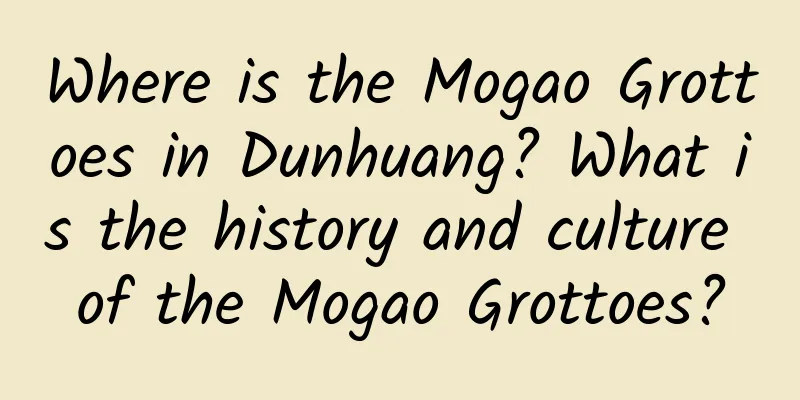Where is the Mogao Grottoes in Dunhuang? What is the history and culture of the Mogao Grottoes?

|
The first choice for tourism outside the Great Wall - Mogao Grottoes. The construction and historical process of the Dunhuang Grottoes, the long history of Dunhuang, the influential local clans and big families, and the relationship between Dunhuang and the surrounding ethnic groups and the Western Regions are not or rarely recorded in history. There are thousands of portraits of donors in the Dunhuang Grottoes, and more than a thousand of them still have their titles and knots preserved. It can help us understand many historical conditions and historical clues. So where is the Dunhuang Mogao Grottoes? What is the historical culture of the Mogao Grottoes? Let's take a look at the introduction of Encyclopedia Knowledge Network below! Contents of this article 1. Where is the Mogao Grottoes in Dunhuang? 2. What is the historical culture of Mogao Grottoes? 3. What is the common name of Dunhuang Mogao Grottoes? 4. Is the Mogao Grottoes in Dunhuang still open to the public? 1Where is the Mogao Grottoes in Dunhuang?Dunhuang Mogao Grottoes, commonly known as the Thousand Buddha Caves, are located 25 kilometers southeast of Dunhuang City, Gansu Province. They are located in Dunhuang at the western end of the Hexi Corridor and were first built during the Former Qin Dynasty of the Sixteen Kingdoms. In 1961, Mogao Grottoes were announced by the State Council of the People's Republic of China as one of the first batch of national key cultural relics protection units. In 1987, Mogao Grottoes were listed as a World Cultural Heritage. Mogao Grottoes are known as the four major grottoes in China, along with the Yungang Grottoes in Datong, Shanxi, the Longmen Grottoes in Luoyang, Henan, and the Maijishan Grottoes in Tianshui, Gansu. 2What is the history and culture of Mogao Grottoes?Mogao Grottoes were first built during the Sixteen Kingdoms period. According to the Tang Dynasty book "Li Kerang's Stele on the Reconstruction of the Buddha Shrines at Mogao Grottoes", in the second year of the Jianyuan Period of the Former Qin Dynasty, the monk Le Zun passed by this mountain and suddenly saw a golden light shining, as if thousands of Buddhas appeared, so he dug the first cave on the rock wall. After that, Zen Master Faliang and others continued to build caves and practice Zen here, which was called "Mogao Grottoes", meaning "the height of the desert". In later generations, because "Mo" and "Mo" are interchangeable, it was renamed "Mogao Grottoes". The colored sculptures and murals in Mogao Grottoes are mostly Buddhist, such as the statues of Buddha in colored sculptures and murals, the stories of Sakyamuni's previous life, karma, and life story, various sutra paintings, numerous stories of the spread of Buddhism to the East, mythological figures, etc. Each category has a large amount of rich and systematic materials. It also involves India, West Asia, Central Asia, Xinjiang and other regions, which can help people understand the Buddhist thoughts, sects, beliefs, and dissemination in ancient Dunhuang and the Hexi Corridor, the integration of Buddhism with traditional Chinese culture, and the process of Buddhism's sinicization. 3What is the common name of Dunhuang Mogao Grottoes?The Mogao Grottoes in Dunhuang are commonly known as the Thousand Buddha Caves. Mogao Grottoes, commonly known as the Thousand Buddha Caves, are located in Dunhuang at the western end of the Hexi Corridor. First built during the Former Qin period of the Sixteen Kingdoms, it has undergone construction during the Sixteen Kingdoms, Northern Dynasties, Sui, Tang, Five Dynasties, Western Xia, and Yuan dynasties, forming a huge scale with 735 caves, 45,000 square meters of murals, and 2,415 clay sculptures. It is the largest and most content-rich Buddhist art site in the world. 4Are the Mogao Grottoes in Dunhuang still open to the public?Dunhuang Mogao Grottoes is the general name of Mogao Grottoes and Western Thousand Buddha Caves in Dunhuang City, Gansu Province. It is one of the four famous grottoes in my country and the world's largest and best-preserved Buddhist art treasure house. It is located 25 kilometers southeast of Dunhuang City. It is the largest and most content-rich treasure house of classical culture and art in my country and a world-famous Buddhist art center. It was listed as a World Cultural Heritage by UNESCO in December 1987. Dunhuang is a famous tourist attraction in China along the Silk Road, and the world-famous Mogao Grottoes are even more popular. What makes Mogao Grottoes famous is the murals, which are the focus of the visit when traveling. |
<<: Where is the Mogao Grottoes? Why is it called Mogao Grottoes?
>>: What is there in Mogao Grottoes? What is the detailed introduction of Mogao Grottoes?
Recommend
How to tighten the female vagina
With people's demands and the attention and i...
What is the story behind the origin of the marathon? Marathon distance
Marathon has become a mainstream sport. Whether i...
Why is my vagina burning?
Normal people will not feel burning pain in the r...
"Open your mouth" to talk about health, the truth about temporomandibular joint disorder
Author: Chen Hua, Shenzhen University General Hos...
Why is there purple in vaginal discharge?
Women's leucorrhea is a very unique physiolog...
What to do if your feet are swollen and painful when you are more than 7 months pregnant
When the pregnancy reaches seven months, the bell...
Why are nipples itchy?
If you feel itchy nipples, you may have breast ec...
A 44-year-old woman suddenly stopped having her period
What should a 44-year-old woman do if she suddenl...
A family of three was poisoned after eating leftover salad! Should we stop eating leftover food?
Every summer, "leftover food" becomes a...
Benefits of brisk walking for women
Brisk walking is as good as jogging. Brisk walkin...
Complete breast cancer resection
Basically every woman is very afraid of breast ca...
What to do if the coccyx hurts during the confinement period
Many women always feel pain in their coccyx durin...
How to prevent hand, foot and mouth disease in daily life
As the weather gets hotter in summer, hand, foot ...
What kind of sugar is better for candied silk?
We all know that candied vegetables are a common ...
Can children also get kidney disease? Parents should not ignore these symptoms!
In most people's minds, kidney disease seems ...









